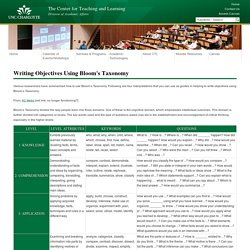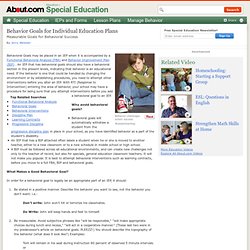

Wheels: Educational & Teaching Products. Writing Objectives Using Bloom's Taxonomy. Various researchers have summarized how to use Bloom’s Taxonomy.

Following are four interpretations that you can use as guides in helping to write objectives using Bloom’s Taxonomy. From: KC Metro [old link, no longer functioning?] Bloom’s Taxonomy divides the way people learn into three domains. One of these is the cognitive domain, which emphasizes intellectual outcomes. This domain is further divided into categories or levels. From: UMUC From: Stewards Task Oriented Question Construction Wheel Based on Bloom’s Taxonomy Task Oriented Question Construction Wheel Based on Bloom’s Taxonomy. ©2001 St. From: GA Tech According to Benjamin Bloom, and his colleagues, there are six levels of cognition: Ideally, each of these levels should be covered in each course and, thus, at least one objective should be written for each level.
Below are examples of objectives written for each level of Bloom’s Taxonomy and activities and assessment tools based on those objectives. IEP Goal Bank. This IEP GOAL BANK is the place where you can "deposit" your own IEP goals/objectives and "withdraw" the goals/objectives contributed by others.

Few things cause more angst in our profession than writing IEP goals/objectives! One way to simplify the process is to use the template below. If all sections of this template are filled in, then your goal/objective is measurable. IEP Goal/Objective Template: From a baseline of ___, the student will.... perform a specific skill a specified number of times under specified conditions at a specified level of achievement for a specific length of time. For example: From a baseline of 55% at the single word level, Joey will... correctly produce an /s/ in the initial position of 25 words from his classroom curriculum after highlighting those sounds as a visual reminder in 8 of 10 trials (80% accuracy) for three consecutive therapy sessions.
IMPORTANT NOTE: You will likely NOT be able to use these goals/objectives "as is. " 3. 4. Fluency Goals: I. II. IEP Tool Box. The Goal Bank. Iep.goal.bank. IEP Goals for Behavior Plans. Behavioral Goals may be placed in an IEP when it is accompanied by a Functional Behavioral Analysis (FBA) and Behavior Improvement Plan (BIP) .

An IEP that has behavioral goals should also have a behavioral section in the present levels, indicating that behavior is an educational need. If the behavior is one that could be handled by changing the environment or by establishing procedures, you need to attempt other interventions before you alter an IEP. With RTI (Response to Intervention) entering the area of behavior, your school may have a procedure for being sure that you attempt interventions before you add a behavioral goal to an IEP. Why avoid behavioral goals? Behavioral goals will automatically withdraw a student from the progressive discipline plan in place in your school, as you have identified behavior as a part of the student's disability. What Makes a Good Behavioral Goal? In order for a behavioral goal to legally be an appropriate part of an IEP, it should: Writing SMART IEP goals and objectives.